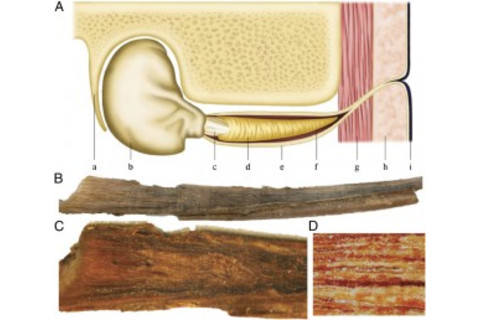Photo: Wikimedia Commons
You know what they say about huge animals, don't you? They have huge balls... of earwax! Take blue whales, for example: according to this study, they carry around 10-inch long plugs of earwax. The earwax accumulates in concentric layers over the entire lifetime of the whale, with the oldest layers towards the center and the newest closest to the skin (see figure below). And because earwax is hydrophobic, it can absorb fat-soluble compounds, including some hormones and pollutants. These two properties allow scientists to "read" these earwax plugs and trace the life histories of the whales, including times of stress (via cortisol levels) and exposure to contaminants such as mercury. Although the earwax can only be retrieved from dead whales (the sample used in this study came from a whale who died after being hit by a ship), studying these plugs will allow scientists to learn about the pollutants that whales are exposed to. Come on--that's probably the coolest thing about earwax you've learned today!
Blue whale earplug reveals lifetime contaminant exposure and hormone profiles. "Lifetime contaminant and hormonal profiles have been reconstructed for an individual male blue whale (Balaenoptera musculus, Linnaeus 1758) using the earplug as a natural aging matrix that is also capable of archiving and preserving lipophilic compounds. These unprecedented lifetime profiles (i.e., birth to death) were reconstructed with a 6-mo resolution for a wide range of analytes including cortisol (stress hormone), testosterone (developmental hormone), organic contaminants (e.g., pesticides and flame retardants), and mercury. Cortisol lifetime profiles revealed a doubling of cortisol levels over baseline. Testosterone profiles suggest this male blue whale reached sexual maturity at approximately 10 y of age, which corresponds well with and improves on previous estimates. Early periods of the reconstructed contaminant profiles for pesticides (such as dichlorodiphenyltrichloroethanes and chlordanes), polychlorinated biphenyls, and polybrominated diphenyl ethers demonstrate significant maternal transfer occurred at 0-12 mo. The total lifetime organic contaminant burden measured between the earplug (sum of contaminants in laminae layers) and blubber samples from the same organism were similar. Total mercury profiles revealed reduced maternal transfer and two distinct pulse events compared with organic contaminants. The use of a whale earplug to reconstruct lifetime chemical profiles will allow for a more comprehensive examination of stress, development, and contaminant exposure, as well as improve the assessment of contaminant use/emission, environmental noise, ship traffic, and climate change on these important marine sentinels."

Fig. 1 Illustration of a blue whale earplug. (A) Schematic diagram showing the location of the earplug within the ear canal: (a) whale skull, (b) tympanic bulla, (c) pars flaccida/tympanic membrane (“glove finger”), (d) cerumen (earplug), (e) external auditory meatus, (f) auditory canal, (g) muscle tissue, (h) blubber tissue, and (i) epidermis. (B) Extracted blue whale earplug; total length 25.4 cm. (C) Earplug longitudinal cross-section. (D) View (20×) of earplug cross-section showing discrete laminae. Related content: NCBI ROFL: Whale ménage à trois: now with 1,000-kg testes! NCBI ROFL: A novel method for the removal of ear cerumen. Flashback Friday: Could the next all-natural insect repellent be made out of earwax?














